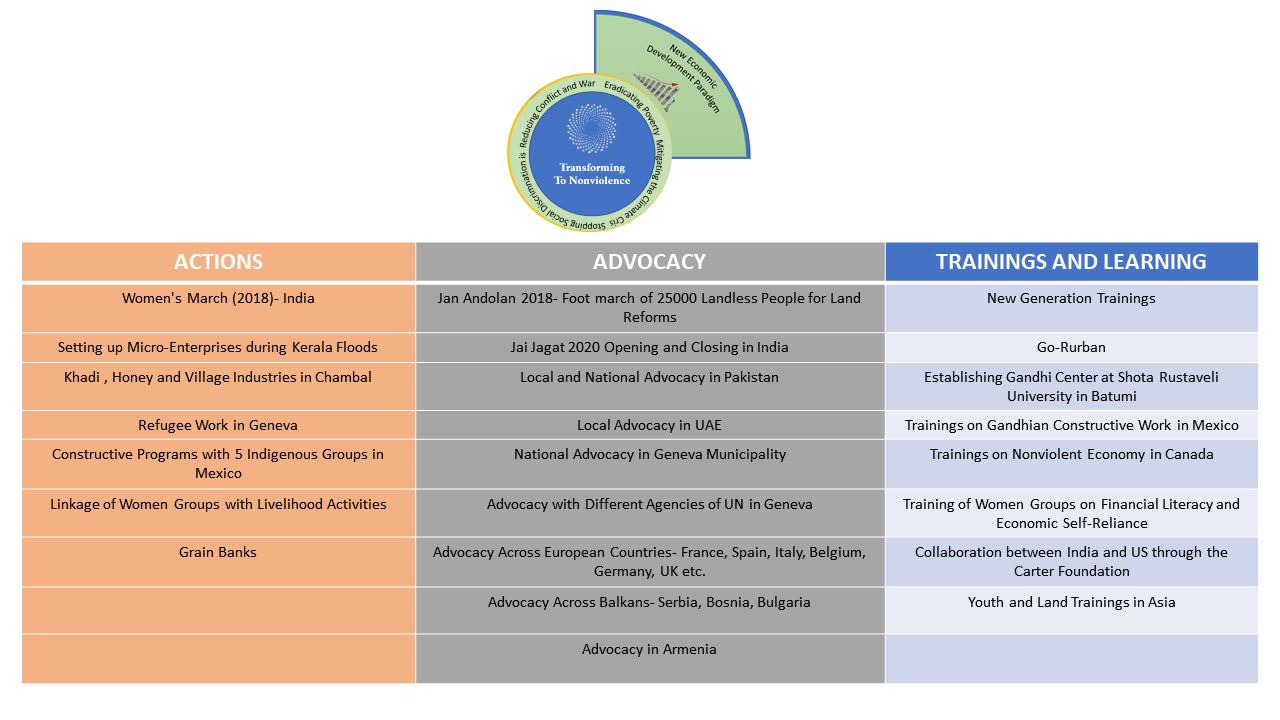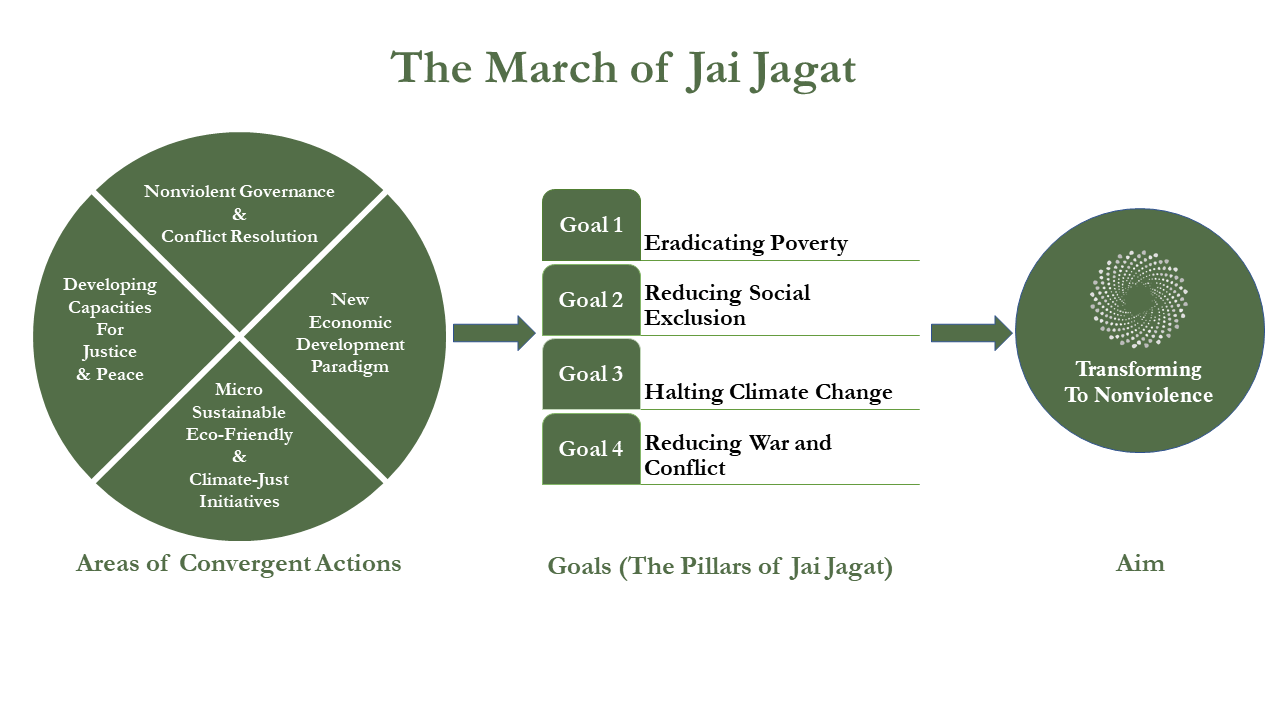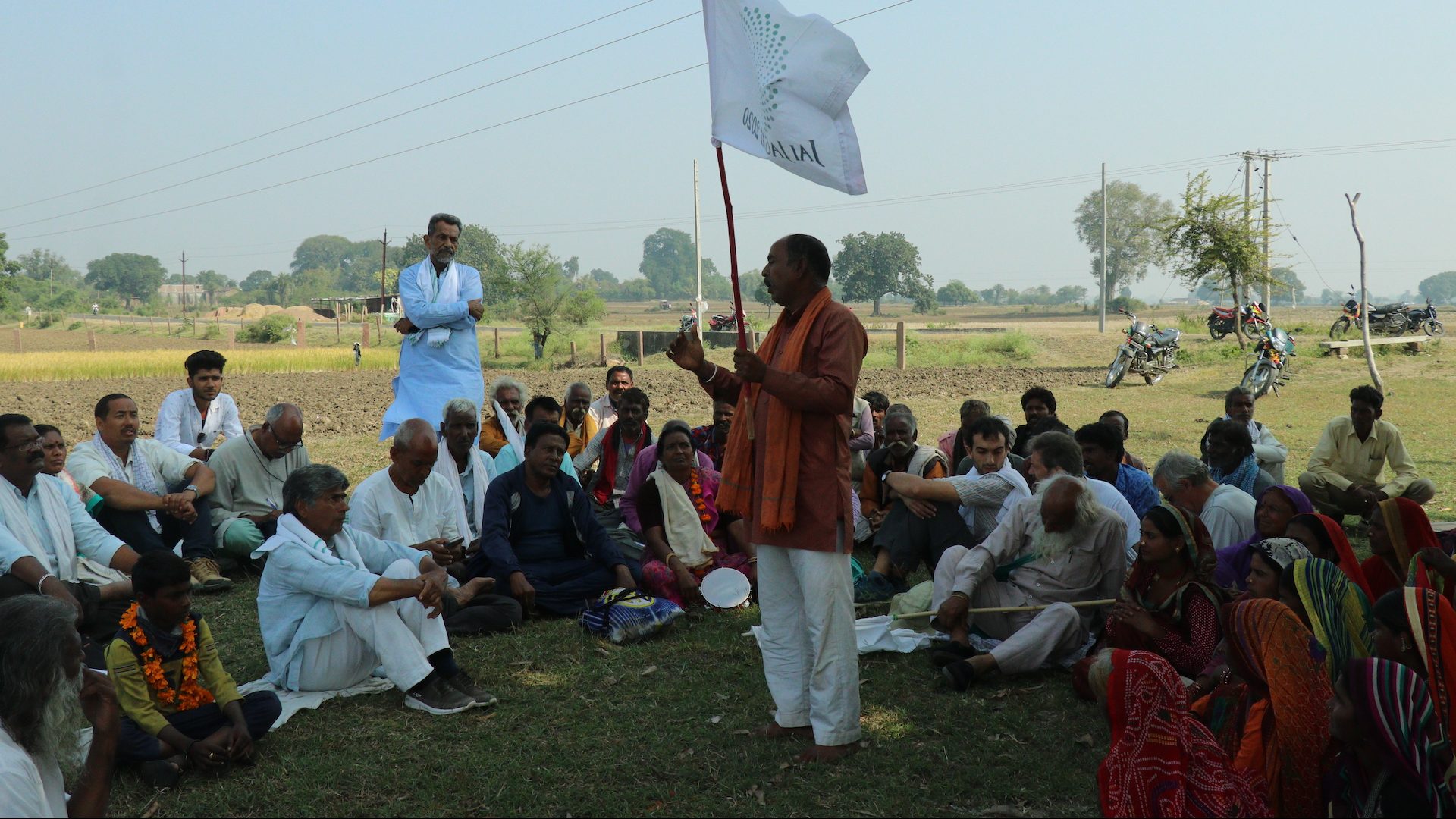ACT NOW!
Your Actions Connect to the Four Pillars
The four pillars are the overarching goals of the Jai Jagat. They are the vision. In any situation they are the normative from which we measure the extent of the application of nonviolence. For instance in the case of the COVID-19 period, let us say that there is an increase of poverty because of ‘lockdowns’ and the lack of daily wage labour employment leading to increased hunger. To carry out Jai Jagat we need to address this situation to eradicate poverty. This first pillar guides our action. The same applies with the other three pillars: removal of social exclusion; halting climate change; stopping war and conflict.

The Jai Jagat website is a space for informing others of the nonviolent actions that you are taking up. These can be local actions, cross-border actions, advocacy actions, global actions. THEY ARE ACTIONS.
As Gandhi said: “Be the change you want to see in the world”.
It is what you do ‘nonviolently’ that makes this action different.
As Rajagopal says: “ Between silence and violence is active nonviolence”
We are creating a map of all your nonviolent actions: it will help us to see how many actions are in different countries and across the world. Once this becomes larger, it will be converted to a portal. Gradually we anticipate that this map will help us to link local actions to global issues.
There are many that have undertaken local actions that can be aligned with Jai Jagat. There are also those beginning new actions. The common theme is that we are #onthemoveforjusticeandpeace.
Justice and Peace are big words. What is meant by this in the Jai Jagat Campaign?
We have devised four Areas of Convergent actions that bring Justice and Peace Together. These are:
- Nonviolent Governance and Conflict Resolution
- New Economic Development Paradigm
- Micro-Sustainable, Eco-Friendly and Climate-Just Initiatives
- Developing Capacities for Justice and Peace
One these four areas of action converge, they achieve a holistic peace.
FOUR AREAS OF CONVERGENT ACTIONS

Nonviolent Governance and Conflict Resolution
Politics is the art of organizing the society. Gandhi said: “The best politics is right action.” For Gandhi ‘party politics tended towards the triumph of the unexamined views of obedient masses; this was distinct from democratic governance,which Gandhi viewed on the maturity of citizens and civic action. This may include some of the following:
- Appreciate people’s initiatives that are coming from citizens and civil society.
- Give space to people, especially those marginalized, to be self-reliant and innovative and respect that local knowledge and practices ought to guide decision-making.
- Give opportunity for leaders that support policies and programs that are pro-people, pro-poor and pro-nature.
- Introduce a nonviolent lens in decision-making so as to assess the value of social, economic and cultural policies and programs.
- Build conflict resolution into the government structure such as Ministries of Peace.
- Ensure that conflict resolution deepens the capacity of Government and civil society to dialogue with conflicting views and perceptions, and resolve issues through mutually-agreeable solutions.
Below you will find a chart which indicates various actions that relate to Nonviolent Governance and Conflict Resolution. They are divided into Actions, Advocacy and Training/Learning:

New Economic Development Paradigm
Why the need for a new economic and development paradigm?
Politics is the art of organizing the society.
Economics is derived from the Greek word Oikonomia which means household management.
We have forgotten the meaning of these spheres of action in the race for social progress. Economic self-interest, private property, the market as central to all political economy, a globalization based on lending and growing money, are characteristics which are being challenged today.
This looks challenging because of what we are used to for so many years, but in looking at the fragile realtionship with nature, this is a prudent choice in the medium and long-term. WE have seen by the trends of environmental unsustainability, the climate crisis, and how increased poverty, social exclusion and war and conflict (what we call four pillars).
A well-organized economy will enhance the happiness and well-being of individuals and the society. (See President of Jai Jagat International Association, Olivier de Schutter’s analysis in Happiness within Boundaries.)
What are some of the components of this new economic and development paradigm from which we are advocating global policy change?
- To base the economy on the community, the neighbourhood with an access to basic needs within a 100 kilometer radius;
- To refocus local needs based on sustaining (regenerating) local resources, and regarding the use of local skills, capacities and traditional knowledge as fundamental to development;
- To reinforce trusteeship attitude towards use, protection and regeneration of nature (eco-resources);
- To reinforce trusteeship in production of goods and in limiting excessive consumption and minimizing the value chains between production and consumption;
- To enhance mutual cooperation between communities;
- To create relations with the state (government) for them to facilitate local economic planning and linking across borders;
- To make the state accountable for “bottom-up” development with consideration to cross-border exchange and trade;
- To enhance a post-fossil fuel economy working to enhance green energy; and
- To privilege and subsidize small cottage industries and small and medium enterprises as opposed to large infrastructural and industrial businesses.
Below you will find a chart which indicates various actions that relate to New Economic Development Paradigm. They are divided into Actions, Advocacy and Training/Learning:

Micro-Sustainable, Eco-Friendly and Climate-Just Initiatives
This is the domain for civic actors to bring forward micro-initiatives that are: sustainable, equitable and nonviolent. This is what Gandhi called “constructive programs”. They cater to basic needs that are local, and have elements of trusteeship built into the initiatives so that all members of communities are included.
Eco-friendly initiatives are not only economic, they are ensuring minimum exploitation of nature (eco-resources); for without natural regeneration, there is no guarantee of human existence. The well-being of people, especially those that are nature dependent like farmers and forest dwellers, and who are the trustees of the earth’s resources, are directly threatened, and this impacts the survival of everyone.
Climate justice means that the climate crisis impacts the poor, marginalized and nature-based communities disproportionately; therefore they need to be a focus in micro-initiatives. Similarly those climate mitigation and climate adaption measures taken, can widen the inequity gap between those that benefit and those that suffer adverse consequences. It requires change in attitude and lifestyle. Climate justice can restore a positive attitude of people to bio-speheres and eco-resources.
Below you will find a chart which indicates various actions that relate to Micro-Sustainable, Eco-Friendly and Climate-Just Initiatives. They are divided into Actions, Advocacy and Training/Learning:

Developing Capacities for Justice and Peace
When young people/students/children/teachers/parents begin to relate issues of nonviolence into learning and education, then there begins a ripple chain reaction of cooperation as opposed competition. Competition with oneself, cooperation with others. There are instances of teachers/young people learning to cooperate by using conflict resolution, different methods of reconciliation, exposure across borders, and slow peace learning. The Jai Jagat campaign aims to network these methods so people can develop further applications.
Also developing capacities of adults, gearing them to nonviolent communication, two-way conflict resolution, mediation, and civic action, helps to expand people’s horizons. Understanding peace in social and ecological justice; applying peace in conflict areas; learning through the arts and artifacts; developing inner peace through meditation, music and mindfulness, are all areas that help to nest nonviolence.
Below you will find a chart which indicates various actions that relate to Developing Capacities for Justice and Peace. They are divided into Actions, Advocacy and Training/Learning:

The Campaign
Since the convergence of many actors and actions is done through marches across borders, one of the central activities of the Jai Jagat “the convergence of marchers”. Marching is symbolic of action and bringing forward new ideas of change. Gandhi used the Salt Satyagraha of 1930s to do this and many other Gandhians have built nonviolent social movements through different marches.


